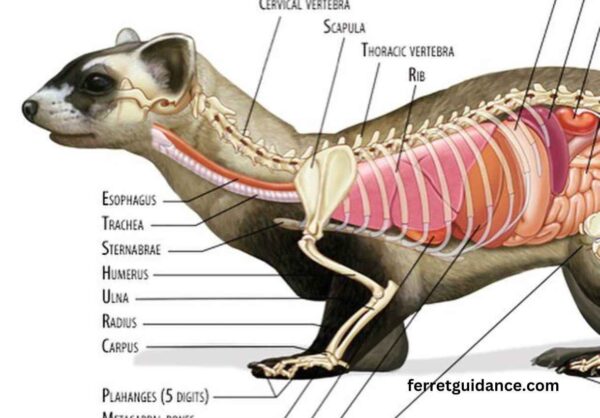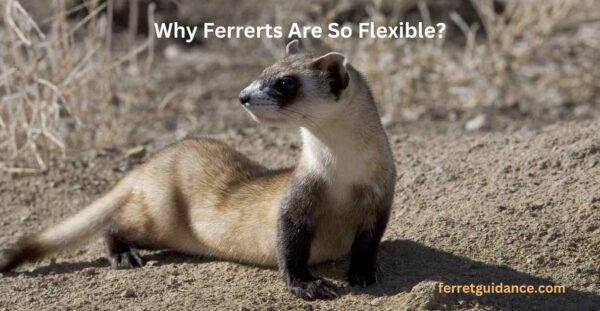Being a ferret owner, have you ever wondered- why ferrets are so flexible?
Ferrets are very fragile animals, they are also very soft in weight. The flexibility of a ferret comes from its unique and strong vertebral column. It is longer than any mammals
Ferrets are much like humans they too consist of more than 200 bones in their whole body which gives them extra flexibility. Ferret’s skeleton structure is so great that it provides super speed and activeness.
Quick answer- Why ferrets are so flexible? Ferrets are one of the most highly flexible pet animals. The body of ferrets are long, and slim, with great flexible ribcage and spine.
Content List
Why ferrets are so flexible?
Ferrets are so flexible that they can enter and come out even with very narrow space holes which makes them even special pets.
You must have noticed that your pet loves to explore unknown places which gives them inner satisfaction with their curious nature.
The complete anatomy of ferrets tells– why ferrets are so flexible? Within ferret anatomy, the skeleton structure of ferrets plays a major role in the flexibility of ferrets.
However, there are more factors than just skeleton structure which you will know in detail in this article.
On that note, giving all the factors and reasons that will answer- why ferrets are so flexible?
The unique ferrets skeleton
Ferrets have unique skeletons than all mammals, like cats, rabbits, and dogs.
As mentioned above above the ferrets have more than 200 bones in their body. But younger ferrets have around 2-3 times more bones than adult ferrets which you can observe if you look closely.

You have to give extra attention to observing it because ferrets’ bones are infused. The ferret vertebrae are a little longer than other mammals while the limb and the neck vertebrae are shorter than other mammals.
The skull in ferrets is comparatively longer than other mammals pets. So, you see that the ferret skeleton structure is an advantage in flexibility for the ferrets.
1. The vertebral column
The immense strength and energy of ferrets are because of the longer vertebral column than other pets and mammals.
The vertebral column is responsible for the high-speed run and sudden movement of the ferrets. This gives them an extra advantage while hunting their prey and also in hiding from their predators.
However, it’s not so common that you will see such high speed and sharp moves in your pet because most of the time they are caged.
But, wild ferrets like black-footed ferrets use this feature. While running in the wild with prey holding in the mouth ferrets use high speed and make sharp moves. It’s the vertebral columns of the ferrets that make it possible.
2. The skull
Ferret’s skulls are sharp, long, and flat which helps them in hunting. The sharp skull of a ferret helps in strong biting, and grabbing prey for a longer period which other pet mammals don’t have.
This major;y helps a wild ferret who runs and makes sudden turns with a flexible body. The bite of ferrets is so sharp and deep that once they hold no prey can get out of it.
3. Leg bones
Ferret’s leg bones are probably the most important parts that enable them to run, stop, and move quickly.
The foot and ankle bones of ferrets are the same. The limb of the ferret is short which gives them extra strength in digging, and climbing.
The body structure of a ferret gives full freedom of running, jumping, climbing, and taking sharp turns. This clearly shows the flexibility level in ferrets’ bodies.
A ferret can jump 5-8 times to their body length without any injury.
4. Arm bones
Ferret’s arm bones are comparatively shorter than other mammals. The arm bones of the ferret are connected with the scapula, humerus, Radis, and ulna of the body.

The arm of the ferrets are highly strong as they are extra large for digging.
The arm of the ferret has a five-digit front and back with tiny bones. Tenderous is a place where they pass over the joints.
5. The pelvis
The pelvis of the ferret is made up of 2 os coxae and 1 sacrum which is the same as other carnivore animals.
Ferret pelvis is different from than human which is twisted because of the upright posture.
6. Back and chest bones
The length of vertebrates differs in all carnivores including humans. The length of neck bones is short in humans as ferrets have cervical vertebrae which are smaller.
So, the length of the vertebrae gives the right balance and strength for the neck of a carnivore here are human beings and ferrets.
Following is the comparison between ferrets and humans
| Ferrets | Humans |
| 5 T with 30 ribs | 12 Thoracic vertebrae |
| 8 bones of Sternum | 1 or 2 bones |
| 5-6 Lumbar vertebrae | 5 |
| 3 sacral vertebrae | 5 |
7. The tail
Generally, the length of the ferret tail of half of the body’s length. This length of ferret tail helps them make sudden sharp turns with higher speed.
The vertebral columns of the ferrets are long, strong, and flexible enough to enable them to enter small places.
8. Head bones
The head of the ferret is also quite different than the pet animal. There are 9 hyoid bones in the head of the ferrets.
The incisors in the ferret are connected in 2 premaxillary bones. While the human head didn’t have these bones.
The rest of the skull of the ferret is quite the same as humans only one to two bone varaies. So, we can ferret head bones also play a major role in the unique skeleton of the ferrets.
9. Toenails
Along with being cute, fragile pets ferrets are also known for the high speed and excellent hunting capacity of their prey.
The high speed and hunting quality of ferrets are majorly blackened by their strong and sharp toenails.
Ferret toenails make them catch prey so quickly and strongly that it becomes impossible to come out of it. Toenails also help ferrets in climbing, digging, and tearing.
So, as a ferret owner, you should be aware when handling or holding your lovely furry ferret, because you never know when toenails give you scratches knowingly or unknowingly.
Why are ferrets so wiggly?
To understand why are ferrets so wiggly we need to know the species of ferrets.
Pet ferrets belong to the mustelid family and all the animals in this group are adept at maneuvers below the ground.

This is the exact reason behind ferret wiggly quality or nature. Such an advantage for ferrets gives freedom to bend their body up to 180 degrees both horizontally and vertically.
Are ferrets spines fragile?
Yes, ferrets’ spines are very fragile. It can seriously be damaged when bent too quickly so you need to be extra careful about it.
Especially if you have kids at your home then always supervise the kids about how they treat your pet ferret.
Kids don’t have much understanding of what’s wrong and what’s right for the ferrets.
So there are changes that kids be rough to the ferret while playing with it and make jump your furry friend from height. This may result in serious injury to the ferret spines.
Do ferrets have flexible bones?
No, ferret bones aren’t flexible but they are quite light and short with a small diameter.
Ferret’s front arm bones follow the same short length and light weight. Additionally, higher length and flexibility of the vertebral column allow ferrets to take sharp turns and sudden U-turns.
Due to the shorter arm bone and longer vertebral columns of ferrets very often, it’s considered that they have flexible bones.
Due to such great flexibility, ferrets run freely in the house, on the ground, and even in narrow places.
Why are ferrets so long?
Ferrets are carnivore animals and are major predator creatures. Naturally, they hunt prey for food.
All of these things are excellently taken care of by the anatomy of the ferret or skeleton structure of the ferrets.
The spines, vertebral column, pelvis, back and chest bones, skull, and more of ferrets are attached and fused in such a way that it gives maximum length to the ferrets.
The length of ferrets increased by 30% to their original length during hunting.
Frequently Asked Questions (FAQs)
Do ferrets get attached to their owners?
Yes, ferrets are highly attached to their respective owners.
How many ribs do ferrets have?
Usually, there are 15 (sometimes 14) paired ribs in ferrets. 10 pair attached to the sternum and 5 attached to each other.
How do ferrets say I love you?
Ferrets say I love you by chasing and wrestling with their owners.
What do ferrets do when they are sad?
A sad ferret usually spends time being alone or sleeping a lot.
Conclusion
I believe now you have the answer- why ferrets are so flexible?
Ferret skeletal structures are unique which is responsible for the splendid flexibility in ferrets. Ferret has a long and slim body with ideal relative weight
The long vertebral columns play a crucial part in ferret flexibility. It gives them the freedom to jump from a high height and enter into narrow places.
The bones of ferrets are fused into muscle which gives them extra strength to bones.
